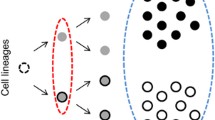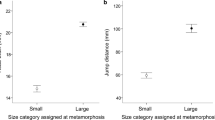Abstract
Life history theory and empirical studies suggest that large size or earlier metamorphosis are suitable proxies for increased lifetime fitness. Thus, across a gradient of larval habitat quality, individuals with similar phenotypes for these traits should exhibit similar post-metamorphic performance. Here we examine this paradigm by testing for differences in post-metamorphic growth and survival independent of metamorphic size in a temperate (spring peeper, Pseudacris crucifer) and tropical (red-eyed treefrog, Agalychnis callidryas) anuran reared under differing larval conditions. For spring peepers, increased food in the larval environment increased post-metamorphic growth efficiency more than predicted by metamorphic phenotype and led to increased mass. Similarly, red-eyed treefrogs reared at low larval density ended the experiment at a higher mass than predicted by metamorphic phenotype. These results show that larval environments can have delayed effects not captured by examining only metamorphic phenotype. These delayed effects for the larval environment link larval and juvenile life history stages and could be important in the population dynamics of organisms with complex life cycles.


Similar content being viewed by others
References
Alford RA, Harris RN (1988) Effects of larval growth history of anuran metamorphosis. Am Nat 131:91–106
Altwegg R, Reyer HU (2003) Patterns of natural selection on size at metamorphosis in water frogs. Evolution 57:872–882
Beckerman A, Benton TG, Ranta E, Kaitala V, Lundberg P (2002) Population dynamic consequences of delayed life-history effects. Trends Ecol Evol 17:263–269
Block MD, Stoks R (2005) Fitness effects from egg to reproduction: bridging the life history transition. Ecology 86:185–197
Briggs VS (2008) Mating patterns of red-eyed treefrogs, Agalychnis callidryas and A. moreletii. Ethology 114:489–498
Brown DD, Cai L (2007) Amphibian metamorphosis. Dev Biol 306:20–33
Chelgren ND, Rosenberg DK, Heppell SS, Gitelman AI (2006) Carryover aquatic effects on survival of metamorphic frogs during pond emigration. Ecol Appl 16:250–261
Cottingham KL, Lennon JT, Brown BL (2005) Knowing when to draw the line: designing more informative ecological experiments. Front Ecol Environ 3:145–152
Gillooly JF, Brown JH, West GB, Savage VM, Charnov EL (2001) Effects of size and temperature on metabolic rate. Science 293:2248–2251
Gimenez L (2006) Phenotypic links in complex life cycles: conclusions from studies with decapods crustaceans. Integr Comp Biol 46:615–622
Gosner KL (1960) A simplified table for staging amphibian embryos and larvae with notes on identification. Herpetologica 16:183–190
Gosner KL, Rossman DA (1960) Eggs and larval development of the treefrogs Hyla crucifer and Hyla ocularis. Herpetologica 16:225–232
Grayson KL, Cook LW, Todd MJ, Peirce D, Hopkins AH, Gatten RE Jr, Dorcas ME (2005) Effects of prey type on specific dynamic action, growth and mass conversion efficiencies in the horned frog, Ceratophrys cranwelli. Comp Biochem Physiol A 141:298–304
Ishizuya-Oka A, Shi Y (2005) Molecular mechanisms for thyroid hormone-induced remodeling in the amphibian digestive tract: a model for studying organ regeneration. Dev Growth Differ 47:601–607
Karraker NE, Gibbs JP, Vonesh JR (2008) Impacts of road deicing salt on the demography of vernal pool-breeding amphibians. Ecol Appl 18:724–734
Leips J, Travis J (1994) Metamorphic responses to changing food levels in two species of hylid frogs. Ecology 75:1345–1356
Maldonado M, Young CM (1999) Effects of the duration of larval life on postlarval stages of the demosponge Sigmodacia caerulea. J Exp Mar Biol Ecol 232:9–21
Marden JH, Fescemyer HW, Saastamoinen M, MacFarland SP, Vera JC, Frilander MJ, Hanski I (2008) Weight and nutrition affect pre-mRNA splicing of a muscle gene associated with performance, energetic and life history. J Exp Biol 211:3653–3660
Marshall DJ, Keough MJ (2005) Offspring size effects in the marine environment: a field test for a colonial invertebrate. Austral Ecol 30:275–280
McCoy KA, McCoy MW, Amick A, Guillette LJ, St Mary CM (2007) Tradeoffs between somatic and gonadal investments during development in the African clawed frog (Xenopus laevis). J Exp Zool A 307:637–646
McCoy MW, Barfield M, Holt RD (2009) Predator shadows: complex life histories as generators of spatially patterned indirect interactions across ecosystems. Oikos 118:87–100
Morey S, Reznick D (2001) Effects of larval density on postmetamorphic spadefoot toads (Spea hammondii). Ecology 82:510–522
Paradis AR, Pepin P, Brown JA (1996) Vulnerability of fish eggs and larvae to predation, review of the influence of relative size of prey and predator. Can J Fish Aquat Sci 53:1226–1235
Peacor SD, Bence JR, Pfister CA (2007) The effect of size-dependant growth and environmental factors of animal size variability. Theor Popul Biol 71:80–94
Pechenick JA (2006) Larval experience and latent effects—metamorphosis is not a new beginning. Integr Comp Biol 46:323–333
Pechenick JA, Wendt DE, Jarrett JN (1998) Metamorphosis is not a new beginning. Bioscience 48:901–910
Phillips NE (2004) Variable timing of larval food has consequences for early juvenile performance in a marine mussel. Ecology 85(8):2341–2346
Podolsky RD, Moran AL (2006) Integrating function across marine life cycles. Integr Comp Biol 46:577–586
Pyburn WF (1970) Breeding behavior of the leaf-frogs Phyllomedusa callidryas and Phyllomedusa dacnicolor in Mexico. Copeia 2:209–218
Reading CJ (2007) Linking global warming to amphibian declines through its effects on female body condition and survivorship. Oecologia 151:125–131
Relyea RA (2001) The lasting effects of adaptive plasticity: predator-induced tadpoles become long legged frogs. Ecology 82:1947–1955
Relyea RA (2003) Predator cues and pesticides: a double dose of danger for amphibians. Ecol Appl 13:1515–1521
Relyea RA (2005) The lethal impact of roundup on aquatic and terrestrial amphibians. Ecol Appl 15:1118–1124
Rohr JR, Sager T, Sesterhenn TM, Palmer BD (2006) Exposure, postexposure, and density-mediated effect of atrazine on amphibians: breaking down net effects into their parts. Environ Health Perspect 114:46–50
Rubbo MJ, Keisecker JM (2004) Leaf litter composition and community structure: translating regional species changes into local dynamics. Ecology 85:2519–2525
Rudolf VHW, Rodel MO (2007) Phenotypic plasticity and the optimal timing of metamorphosis under uncertain time constraints. Evol Ecol 21:121–142
Schreiber S, Rudolf VHW (2008) Crossing habitat boundaries: coupling dynamics of ecosystems through complex life cycles. Ecol Lett 11:576–587
Semlitsch RD, Scott DE, Pechmann JHK (1988) Time and size at metamorphosis related to adult fitness in Ambystoma talpoideum. Ecology 69:184–192
Slos S, Stocks R (2008) Predation risk induces stress proteins and reduces antioxidant defense. Funct Ecol 22:637–642
Smith DC (1987) Adult recruitment in chorus frogs—effects of size and date at metamorphosis. Ecology 68:344–350
Tarvin, R (2009) Post-metamorphic growth of red-eyed treefrogs (Agalychnis callidryas): variation with size at metamorphosis, foraging, and activity. Undergrad thesis, Boston University
Taylor BW, Anderson CR, Peckarsky BL (1998) Effects of size at metamorphosis on stonefly fecundity and reproductive success. Oecologia 114:494–502
R Development Core Team (2007) R: a language and environment for statistical computing. R Foundation for Statistical Computing, Vienna, Austria. ISBN 3-900051-07-0. http://www.R-project.org
Twombly S (1996) Timing of metamorphosis in a freshwater crustacean: comparison with anuran models. Ecology 77:1855–1866
Vonesh JR (2005) Sequential predator effects across three life stages on the African tree frog, Hyperolius spinigularis. Oecologia 143:280–290
Vonesh JR, Warkentin KM (2006) Opposite shifts in size at metamorphosis in response to larval and metamorph predators. Ecology 87(3):556–562
Werner EE (1986) Amphibian metamorphosis—growth-rate, predation risk, and the optimal size at transformation. Am Nat 128:319–341
Wilbur HM, Collins JP (1973) Ecological aspects of amphibian metamorphosis. Science 182:1305–1314
Zera AJ, Harshman LG (2001) The physiology of life history trade-off in animals. Annu Rev Ecol Syst 32:95–126
Acknowledgments
We thank Anssi Laurila and three anonymous reviewers for valuable comments on an earlier version of this manuscript. We thank J. Hite, J. Kraus, K. Grayson, V. Rudolf, K. Warkentin, and R. Niccoli for help during research and manuscript preparation. We thank the Virginia Department of Game and Inland Fisheries (permit number 031450), the Virginia Commonwealth University (VCU) Animal Use and Care Committee (IACUC no. AM10112), the Smithsonian Tropical Research Institute and the Panamanian Autoridad Nacional del Ambiente for permission to conduct this research. Financial support was provided by NSF DEB-0717220, Grants-In-Aid of Research from the National Academy of Science administered by Sigma Xi, the scientific research society, the VCU Rice Center Student Research Funding Grant, and the Smithsonian Tropical Research Institute. The authors declare that all experiments followed the current laws of the countries they were conducted in. This is Rice Center contribution number 013.
Author information
Authors and Affiliations
Corresponding author
Additional information
Communicated by Anssi Laurila.
Rights and permissions
About this article
Cite this article
Van Allen, B.G., Briggs, V.S., McCoy, M.W. et al. Carry-over effects of the larval environment on post-metamorphic performance in two hylid frogs. Oecologia 164, 891–898 (2010). https://doi.org/10.1007/s00442-010-1728-8
Received:
Accepted:
Published:
Issue Date:
DOI: https://doi.org/10.1007/s00442-010-1728-8




